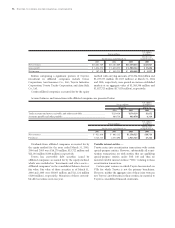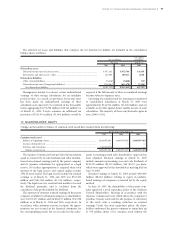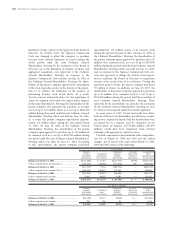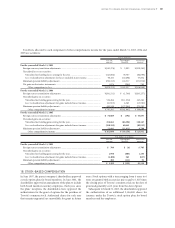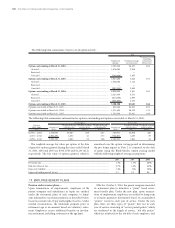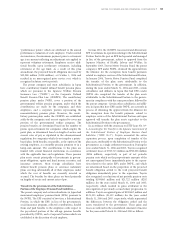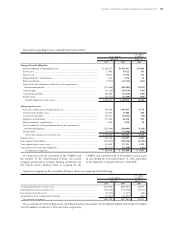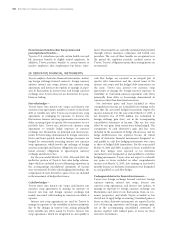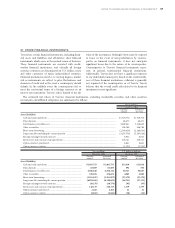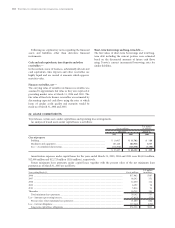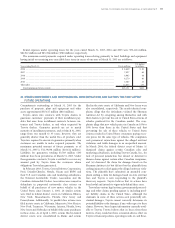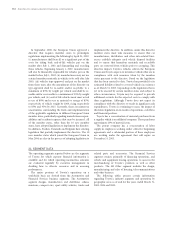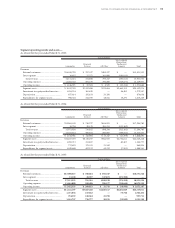Toyota 2005 Annual Report Download - page 105
Download and view the complete annual report
Please find page 105 of the 2005 Toyota annual report below. You can navigate through the pages in the report by either clicking on the pages listed below, or by using the keyword search tool below to find specific information within the annual report.
NOTES TO CONSOLIDATED FINANCIAL STATEMENTS >103
“performance points” which are attributed to the annual
performance evaluation of each employee. Under normal
circumstances, the minimum payment prior to retirement
age is an amount reflecting an adjustment rate applied to
represent voluntary retirement. Employees receive addi-
tional benefits upon involuntary retirement, including
retirement at the age limit. As a result of this plan
amendment, the projected benefit obligation decreased by
¥32,208 million ($300 million), at October 1, 2004 and
resulted in an unrecognized prior service cost, which is
recognized in future service periods.
The parent company and most subsidiaries in Japan
have contributory funded defined benefit pension plans,
which are pursuant to the Japanese Welfare Pension
Insurance Law (“JWPIL”) or the Corporate Defined
Benefit Pension Plan Law (CDBPPL). The contributory
pension plans under JWPIL cover a portion of the
governmental welfare pension program, under which the
contributions are made by the companies and their
employees, and a corporate portion representing the
noncontributory pension plans. However, the contri-
butory pension plans under the CDBPPL are established
solely by the companies and are not required to cover any
portion of the governmental welfare program. The
pension benefits are determined based on the number of
points upon retirement for companies which employ the
point plan, or determined based on length of service and
current rates of pay as stipulated in the aforementioned
regulations for companies which do not employ a points-
based plan. Both benefits are payable, at the option of the
retiring employee, as a monthly pension payment or in a
lump-sum amount. The contributions to the plans are
funded with several financial institutions in accordance
with the applicable laws and regulations. These pension
plan assets consist principally of investments in govern-
ment obligations, equity and fixed income securities, and
insurance contracts. Most foreign subsidiaries have
defined benefit pension plans or severance indemnity
plans covering substantially all of their employees under
which the cost of benefits are currently invested or
accrued. The benefits for these plans are based primarily
on lengths of service and current rates of pay.
Transfer to the government of the Substitutional
Portion of the Employee Pension Fund Liabilities—
The parent company and certain subsidiaries in Japan had
maintained employees’ pension funds (EPFs) pursuant to
the JWPIL. The EPF consisted of two tiers, a Substitutional
Portion, in which the EPF, in lieu of the government’s
social insurance program, collected contributions, funded
them and paid benefits to the employees with respect to
the pay-related portion of the old-age pension benefits
prescribed by JWPIL, and a Corporate Portion which was
established at the discretion of each employer.
In June 2001, the CDBPPL was enacted and allowed any
EPF to terminate its operation relating to the Subsititutional
Portion that in the past an EPF had operated and managed
in lieu of the government, subject to approval from the
Japanese Minister of Health, Labour and Welfare. In
September 2003, Toyota Motor Pension Fund, the parent
company’s EPF under JWPIL, obtained the approval from
the Minister for the exemption from benefit payments
related to employee services of the Subsititutional Portion.
In January 2004, Toyota Motor Pension Fund completed
the transfer of the plan assets attributable to the
Subsititutional Portion to the government. In addition,
during the years ended March 31, 2004 and 2005, certain
subsidiaries and affiliates in Japan that had EPFs under
JWPIL also completed the transfer of the plan assets
attributable to the Subsititutional Portion to the govern-
ment in compliance with the same procedures followed by
the parent company. Certain other subsidiaries and affili-
ates in Japan that have EPFs under JWPIL are currently in
process of obtaining the approval from the Minister for
the exemption from the benefit payments related to
employee service of the Subsititutional Portion and upon
approval will transfer the plan assets equivalent to the
Subsititutional Portion to the government.
In accordance with the consensus on EITF Issue No. 03-
2, Accounting for the Transfer to the Japanese Government of
the Substitutional Portion of Employee Pension Fund
Liabilities (“EITF 03-2”), Toyota accounted the entire
separation process, upon completion of transfer of the
plan assets attributable to the Substitutional Portion to the
government, as a single settlement transaction. During the
years ended March 31, 2004 and 2005, Toyota recognized
settlement losses of ¥323,715 million and ¥96,066 million
($894 million), respectively, as part of net periodic
pension costs which are the proportionate amounts of the
net unrecognized losses immediately prior to the separa-
tion related to the entire EPFs under JWPIL, and which
are determined based on the proportion of the projected
benefit obligation settled to the total projected benefit
obligation immediately prior to the separation. Toyota
also recognized as reductions of net periodic pension costs
totaling ¥109,885 million and ¥21,722 million ($202
million) for the years ended March 31, 2004 and 2005,
respectively, which resulted in gains attributed to the
derecognition of previously accrued salary progression. In
addition, Toyota recognized gains of ¥320,867 million and
¥121,553 million ($1,132 million) for the years ended
March 31, 2004 and 2005, respectively, which represented
the differences between the obligation settled and the
assets transferred to the government. These gains and
losses are reflected in the consolidated statement of income
for the years ended March 31, 2004 and 2005 as follows:



